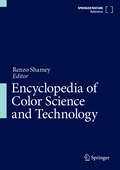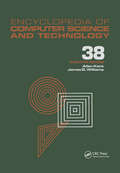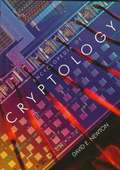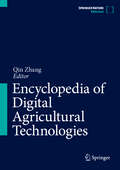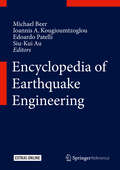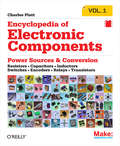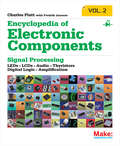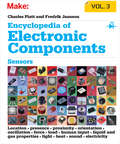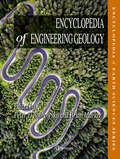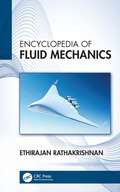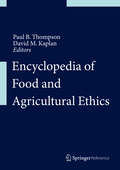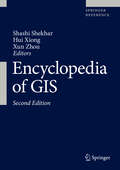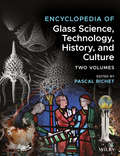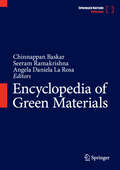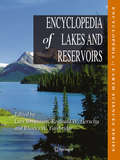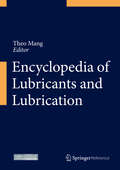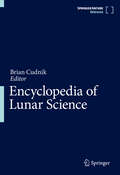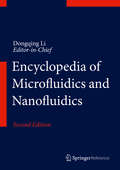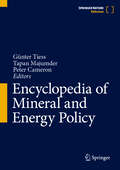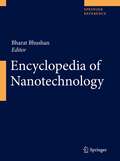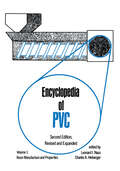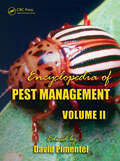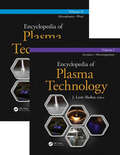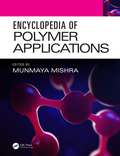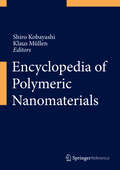- Table View
- List View
Encyclopedia of Color Science and Technology
by Renzo ShameyThis fully revised and expanded 2nd edition provides a single authoritative resource describing the concepts of color and the application of color science across research and industry. Significant changes for the 2nd edition include: New and expanded sections on color engineeringMore entries on fundamental concepts of color science and color termsMany additional entries on specific materialsFurther material on optical concepts and human visual perceptionAdditional articles on organisations, tools and systems relevant to colorA new set of entries on 3D presentation of color In addition, many of the existing entries have been revised and updated to ensure that the content of the encyclopedia is current and represents the state of the art. The work covers the full gamut of color: the fundamentals of color science; the physics and chemistry; color as it relates to optical phenomena and the human visual system; and colorants and materials. The measurement of color is described through entries on colorimetry, color spaces, color difference metrics, color appearance models, color order systems and cognitive color. The encyclopedia also has extensive coverage of applications throughout industry, including color imaging, color capture, display and printing, and descriptions of color encodings, color management, processing color and applications relating to color synthesis for computer graphics are included. The broad scope of the work is illustrated through entries on color in art conservation, color and architecture, color and education, color and culture, and biographies of some of the key figures involved in color research throughout history. With over 250 entries from color science researchers across academia and industry, this expanded 2nd edition of the Encyclopedia of Color Science and Technology remains the most important single resource in color science.
Encyclopedia of Computer Science and Technology: Volume 38 - Supplement 23: Algorithms for Designing Multimedia Storage Servers to Models and Architectures (Computer Science And Technology Encyclopedia Ser.)
by Allen KentVolume 38 - Supplement 23: Algorithms for Designing Multimedia Storage Servers to Models and Architectures. Covering more than basic computer commands and procedures, this encyclopaedia summarizes how technology has developed, the future of computer programs and applications, and the significance of computer components. Following an introduction and overview, there are approximately 750 to 800 entries.
Encyclopedia of Cryptology
by David E. NewtonAimed at a general audience- perhaps high school students and above- rather than the sophisticated math and computer specialists who deal with the subject at a detailed level. The history, uses, significance, terminology and acronyms, and important personages and events connected with secret writing are explained in 550 entries, each with cross-references and most with suggestions for further reading. Includes an annotated bibliography.
Encyclopedia of Digital Agricultural Technologies
by Qin ZhangDigital agriculture is an emerging concept of modern farming that refers to managing farms using modern Engineering, Information and Communication Technologies (EICT) aiming at increasing the overall efficiency of agricultural production, improving the quantity and quality of products, and optimizing the human labor required and natural resource consumption in operations. This encyclopedia is designed to collect the summaries of knowledge on as many as subjects or aspects relevant to ECIT for digital agriculture, present such knowledge in entries, and arrange them alphabetically by articles titles.Springer Major Reference Works platform offers Live Update capability. Our reference work takes full advantage of this feature, which allows for continuous improvement or revision of published content electronically.The Editorial BoardDr. Irwin R. Donis-Gonzalez, University of California Davis, Dept. Biological and Agricultural Engineering, Davis, USA (Section: Postharvest Technologies)Prof. Paul Heinemann, Pennsylvania State University, Department Head of Agricultural and Biological Engineering, PA, USA (Section: Technologies for Crop Production)Prof. Manoj Karkee, Washington State University, Center for Precision and Automated Agricultural Systems, Washington, USA (Section: Robotics and Automation Technologies)Prof. Minzan Li, China Agricultural University, Beijing, China (Section: Precision Agricultural Technologies)Prof. Dikai Liu, University of Technology Sydney (UTS),Faculty of Engineering & Information Technologies, Broadway NSW, Australia (Section: AI, Information and Communication Technologies)Prof. Tomas Norton, University of Leuven, Dept. of Biosystems, Heverlee Leuven, Belgium (Section: Technologies for Animal and Aquatic Production)Dr. Manuela Zude-Sasse, Leibniz Institute for Agricultural Engineering and Bioeconomy (ATB), Precision Horticulture, Potsdam, Germany (Section: Engineering and Mechanization Technologies)
Encyclopedia of Earthquake Engineering
by Michael Beer Siu-Kui Au Ioannis A. Kougioumtzoglou Edoardo PatelliThe Encyclopedia of Earthquake Engineering is designed to be the authoritative and comprehensive reference covering all major aspects of the science of earthquake engineering, specifically focusing on the interaction between earthquakes and infrastructure. The encyclopedia comprises approximately 300 contributions. Since earthquake engineering deals with the interaction between earthquake disturbances and the built infrastructure, the emphasis is on basic design processes important to both non-specialists and engineers so that readers become suitably well informed without needing to deal with the details of specialist understanding. The encyclopedia's content provides technically-inclined and informed readers about the ways in which earthquakes can affect our infrastructure and how engineers would go about designing against, mitigating and remediating these effects. The coverage ranges from buildings, foundations, underground construction, lifelines and bridges, roads, embankments and slopes. The encyclopedia also aims to provide cross-disciplinary and cross-domain information to domain-experts. This is the first single reference encyclopedia of this breadth and scope that brings together the science, engineering and technological aspects of earthquakes and structures.
Encyclopedia of Electronic Components Volume 1: Resistors, Capacitors, Inductors, Switches, Encoders, Relays, Transistors
by Charles PlattWant to know how to use an electronic component? This first book of a three-volume set includes key information on electronics parts for your projects—complete with photographs, schematics, and diagrams. You’ll learn what each one does, how it works, why it’s useful, and what variants exist. No matter how much you know about electronics, you’ll find fascinating details you’ve never come across before.Convenient, concise, well-organized, and precisePerfect for teachers, hobbyists, engineers, and students of all ages, this reference puts reliable, fact-checked information right at your fingertips—whether you’re refreshing your memory or exploring a component for the first time. Beginners will quickly grasp important concepts, and more experienced users will find the specific details their projects require.Unique: the first and only encyclopedia set on electronic components, distilled into three separate volumesIncredibly detailed: includes information distilled from hundreds of sourcesEasy to browse: parts are clearly organized by component typeAuthoritative: fact-checked by expert advisors to ensure that the information is both current and accurateReliable: a more consistent source of information than online sources, product datasheets, and manufacturer’s tutorialsInstructive: each component description provides details about substitutions, common problems, and workaroundsComprehensive: Volume 1 covers power, electromagnetism, and discrete semi-conductors; Volume 2 includes integrated circuits, and light and sound sources; Volume 3 covers a range of sensing devices.
Encyclopedia of Electronic Components Volume 2: LEDs, LCDs, Audio, Thyristors, Digital Logic, and Amplification
by Charles Platt Fredrik JanssonWant to know how to use an electronic component? This second book of a three-volume set includes key information on electronics parts for your projects--complete with photographs, schematics, and diagrams. You'll learn what each one does, how it works, why it's useful, and what variants exist. No matter how much you know about electronics, you'll find fascinating details you've never come across before.Perfect for teachers, hobbyists, engineers, and students of all ages, this reference puts reliable, fact-checked information right at your fingertips--whether you're refreshing your memory or exploring a component for the first time. Beginners will quickly grasp important concepts, and more experienced users will find the specific details their projects require.Volume 2 covers signal processing, including LEDs, LCDs, audio, thyristors, digital logic, and amplification.Unique: the first and only encyclopedia set on electronic components, distilled into three separate volumesIncredibly detailed: includes information distilled from hundreds of sourcesEasy to browse: parts are clearly organized by component typeAuthoritative: fact-checked by expert advisors to ensure that the information is both current and accurateReliable: a more consistent source of information than online sources, product datasheets, and manufacturer's tutorialsInstructive: each component description provides details about substitutions, common problems, and workaroundsComprehensive: Volume 1 covers power, electromagnetism, and discrete semiconductors; Volume 2 includes LEDs, LCDs, audio, thyristors, digital logic, and amplification; Volume 3 covers a range of sensing devices.
Encyclopedia of Electronic Components Volume 3: Sensors for Location, Presence, Proximity, Orientation, Oscillation, Force, Load, Human Input, Liquid and Gas Properties, Light, Heat, Sound, and Electricity
by Charles PlattWant to know how to use an electronic component? This third book of a three-volume set includes key information on electronics parts for your projects--complete with photographs, schematics, and diagrams. You'll learn what each one does, how it works, why it's useful, and what variants exist. No matter how much you know about electronics, you'll find fascinating details you've never come across before.Perfect for teachers, hobbyists, engineers, and students of all ages, this reference puts reliable, fact-checked information right at your fingertips--whether you're refreshing your memory or exploring a component for the first time. Beginners will quickly grasp important concepts, and more experienced users will find the specific details their projects require.Volume 3 covers components for sensing the physical world, including light, sound, heat, motion, ambient, and electrical sensors.Unique: the first and only encyclopedia set on electronic components, distilled into three separate volumesIncredibly detailed: includes information distilled from hundreds of sourcesEasy to browse: parts are clearly organized by component typeAuthoritative: fact-checked by expert advisors to ensure that the information is both current and accurateReliable: a more consistent source of information than online sources, product datasheets, and manufacturer's tutorialsInstructive: each component description provides details about substitutions, common problems, and workaroundsComprehensive: Volume 1 covers power, electromagnetism, and discrete semi-conductors; Volume 2 includes integrated circuits, and light and sound sources; Volume 3 covers a range of sensing devices.
Encyclopedia of Engineering Geology (Encyclopedia Of Earth Sciences Ser.)
by Peter T. Bobrowsky Claudio Margottini Paul Marinos Brian Marker Martin G. Culshaw Jerome De Graff Laurance Donnelly Michael Hendry Jeffrey R. Keaton Victor Osipov Abdul Shakoor Roy ShlemonThis volume addresses the multi-disciplinary topic of engineering geology and the environment, one of the fastest growing, most relevant and applied fields of research and study within the geosciences. It covers the fundamentals of geology and engineering where the two fields overlap and, in addition, highlights specialized topics that address principles, concepts and paradigms of the discipline, including operational terms, materials, tools, techniques and methods as well as processes, procedures and implications.A number of well known and respected international experts contributed to this authoritative volume, thereby ensuring proper geographic representation, professional credibility and reliability. This superb volume provides a dependable and ready source of information on approximately 300 topical entries relevant to all aspects of engineering geology. Extensive illustrations, figures, images, tables and detailed bibliographic citations ensure that the comprehensively defined contributions are broadly and clearly explained.The Encyclopedia of Engineering Geology provides a ready source of reference for several fields of study and practice including civil engineers, geologists, physical geographers, architects, hazards specialists, hydrologists, geotechnicians, geophysicists, geomorphologists, planners, resource explorers, and many others. As a key library reference, this book is an essential technical source for undergraduate and graduate students in their research. Teachers/professors can rely on it as the final authority and the first source of reference on engineering geology related studies as it provides an exceptional resource to train and educate the next generation of practitioners.
Encyclopedia of Fluid Mechanics
by Ethirajan RathakrishnanThis book was developed using material from teaching courses on fluid mechanics, high-speed flows, aerodynamics, high-enthalpy flows, experimental methods, aircraft design, heat transfer, introduction to engineering, and wind engineering. It precisely presents the theoretical and application aspects of the terms associated with these courses. It explains concepts such as cyclone, typhoon, hurricane, and tornado, by highlighting the subtle difference between them. The text comprehensively introduces the subject vocabulary of fluid mechanics for use in courses in engineering and the physical sciences. This book• Presents the theoretical aspects and applications of high-speed flows, aerodynamics, high-enthalpy flows, and aircraft design.• Provides a ready reference source for readers to learn essential concepts related to flow physics, rarefied, and stratified flows.• Comprehensively covers topics such as laser Doppler anemometer, latent heat of fusion, and latent heat of vaporisation.• Includes schematic sketches and photographic images to equip the reader with a better view of the concepts. This is ideal study material for senior undergraduate and graduate students in the fields of mechanical engineering, aerospace engineering, flow physics, civil engineering, automotive engineering, and manufacturing engineering.
Encyclopedia of Food and Agricultural Ethics
by Paul B. Thompson David M. KaplanThe field of agricultural and food ethics emerged in the 1980 s as scholars began to recognize the need for explicitly normative scholarship on problems and issues associated with the food system. After 25 years of growth, agricultural and food ethics have blossomed in the wake of food safety scandals and renewed interest in alternative ways to organize the agrifood system. There has been a rapid growth in courses taught and in the entry of new researchers into the topics of agricultural and food ethics over the last five years. Scholarship has now reached a point where there is a need for a cross-cutting reference volume that will enable newcomers to the field to gain orientation to the array of topics and problems, existing scholarship on these topics and problems, and key concepts that have been established in agricultural and food ethics. Active scholars in the field would also benefit from literature reviews and survey articles that facilitate a more cumulative trend in research efforts. "
Encyclopedia of GIS
by Shashi Shekhar Hui Xiong Xun ZhouNew In This Edition: This second edition of the Encyclopedia of GIS includes 30% to 50% new content. It provides up-to-date information on emerging topics such as spatial big data, smart-phone GIS, urban computing and mobile recommender systems. It also expands the first edition's rich set of GIS-related commercial and societal applications such as geo-targeting, geo-fencing and understanding climate changes, while enabling more comprehensive coverage of classical GIS topics such as map projections, global positioning systems and spatial cognition. The entries explain the key software, data sets and processes used by geographers and computational scientists. Additionally, the reference emphasizes the role of GIS in business and mobile intelligence. By offering more diversified GIS-related topics from theory and research than most of the other available literature, the authors equip newcomers to the field with principles as well as applications. With an accessible breadth of content and intuitive A-Z organization, this new edition of the encyclopedia is an invaluable reference for newcomers to the field of GIS, as well as researchers, students, developers and professionals who are interested in exploring this new dynamic area. Praise For The First Edition: "The focus here, however, is on the mathematical and computational aspects of GIS . . . . This is very welcome to those practitioners who have been less exposed to some of the mathematical and computational aspects of GIS. This is also very welcome to the researcher or graduate student within any of the interdisciplinary areas that use GIS. . . . I highly recommend it. " (Pascal V. Calarco, ACM Computing Reviews, November, 2008) "This single-volume reference work is a highly welcome . . . addition to the rapidly advancing field of geographic information systems. Peer-reviewed entries from over 300 contributors cover 41 topical subfields, with an overall emphasis on computational aspects of GIS. The volume is adequately illustrated with 723 figures and 90 tables in black and white. A full bibliography and concise list of entry terms are provided at the back of the work. . . . Summing Up: Highly recommended. Upper-division geography students through professionals. " (C. E. Smith, CHOICE, Vol. 45 (11), 2008) "The encyclopedia is divided into 41 fields, each one an important sub-area within GIS. . . . the editors' organization of the material and comprehensive and systematic approach are superb and shall give students, eager readers as well as researchers an understanding of the topics in quite full depth and breadth. . . . is lavishly illustrated with figures, graphs and tables, the design and execution of which are as perfect as the material they illustrate. . . . it is sturdy and opens out nicely for study and reference. " (Current Engineering Practice, 2008).
Encyclopedia of Glass Science, Technology, History, and Culture
by Pascal RichetA comprehensive and up-to-date encyclopedia to the fabrication, nature, properties, uses, and history of glass The Encyclopedia of Glass Science, Technology, History, and Culture has been designed to satisfy the needs and curiosity of a broad audience interested in the most varied aspects of material that is as old as the universe. As described in over 100 chapters and illustrated with 1100 figures, the practical importance of glass has increased over the ages since it was first man-made four millennia ago. The old-age glass vessels and window and stained glass now coexist with new high-tech products that include for example optical fibers, thin films, metallic, bioactive and hybrid organic-inorganic glasses, amorphous ices or all-solid-state batteries. In the form of scholarly introductions, the Encyclopedia chapters have been written by 151 noted experts working in 23 countries. They present at a consistent level and in a self-consistent manner these industrial, technological, scientific, historical and cultural aspects. Addressing the most recent fundamental advances in glass science and technology, as well as rapidly developing topics such as extra-terrestrial or biogenic glasses, this important guide: Begins with industrial glassmaking Turns to glass structure and to physical, transport and chemical properties Deals with interactions with light, inorganic glass families and organically related glasses Considers a variety of environmental and energy issues And concludes with a long section on the history of glass as a material from Prehistory to modern glass science The Encyclopedia of Glass Science, Technology, History, and Culture has been written not only for glass scientists and engineers in academia and industry, but also for material scientists as well as for art and industry historians. It represents a must-have, comprehensive guide to the myriad aspects this truly outstanding state of matter.
Encyclopedia of Green Materials
by Seeram Ramakrishna Chinnappan Baskar Angela Daniela La RosaEncyclopedia of Green Materials covers comprehensive overview, recent research and development of Green Materials and Green Nanomaterials, and their applications in all areas, including electronics, sensors, textiles, biomedical, energy and energy storage, building constructions and interiors design, automotive, green plastic manufacturing, food packing, membrane technology, wastewater treatment, rubber technology, and tire manufacturing. The contents focus on sustainable development, renewable, circular economy, Chemistry 4.0: Chemistry through innovation in transforming the world, green chemistry and green engineering, upcycling, and recycling.
Encyclopedia of Lakes and Reservoirs
by Lars Bengtsson Rhodes W. Fairbridge Reginald W. HerschyLakes and reservoirs hold about 90% of the world's surface fresh water, but overuse, water withdrawal and pollution of these bodies puts some one billion people at risk. The Encyclopedia of Lakes and Reservoirs reviews the physical, chemical and ecological characteristics of lakes and reservoirs, and describes their uses and environmental state trends in different parts of the world. Superbly illustrated throughout, it includes some 200 entries in a range of topics, including acidification, artificialisation, canals, climate change effects, dams, dew ponds, drainage, eutrofication, evaporation, fisheries, hydro-electric power, nutrients, organic pollution, paleolimnology, reservoir capacities and depths, sedimentation, water resources and more.
Encyclopedia of Lubricants and Lubrication
by Theo MangThe importance of lubricants in virtually all fields of the engineering industry is reflected by an increasing scientific research of the basic principles. Energy efficiency and material saving are just two core objectives of the employment of high-tech lubricants. The encyclopedia presents a comprehensive overview of the current state of knowledge in the realm of lubrication. All the aspects of fundamental data, underlying concepts and use cases, as well as theoretical research and last but not least terminology are covered in hundreds of essays and definitions, authored by experts in their respective fields, from industry and academic institutes.
Encyclopedia of Lunar Science
by Brian CudnikThe Encyclopedia of Lunar Science includes the latest topical data, definitions, and explanations of the many and varied facets of lunar science. This is a very useful reference work for a broad audience, not limited to the professional lunar scientist: general astronomers, researchers, theoreticians, practitioners, graduate students, undergraduate students, and astrophysicists as well as geologists and engineers. The title includes all current areas of lunar science, with the topical entries being established tertiary literature. The work is technically suitable to most advanced undergraduate and graduate students. The articles include topics of varying technical levels so that the top scientists of the field find this work a benefit as well as the graduate students and the budding lunar scientists. A few examples of topical areas are as follows: Basaltic Volcanism, Lunar Chemistry, Time and Motion Coordinates, Cosmic Weathering through Meteoritic Impact, Environment, Geology, Geologic History, Impacts and Impact Processes, Lunar Surface Processes, Origin and Evolution Theories, Regolith, Stratigraphy, Tectonic Activity, Topography, Weathering through ionizing radiation from the solar wind, solar flares, and cosmic rays.
Encyclopedia of Microfluidics and Nanofluidics
by Dongqing LiCovering all aspects of transport phenomena on the nano- and micro-scale, the 800 entries include 300 essay entries. The Encyclopedia gives an up to date look at the fundamentals of the field as well as many experiments and applications in growing areas such as energy devices and bioengineering applications.
Encyclopedia of Mineral and Energy Policy
by Peter Cameron Günter Tiess Tapan MajumderThis Encyclopedia provides a cutting-edge, up-to-date reference source on mineral and energy policies around the world. It offers information on GDP, population, investment scenarios and current environmental regulations in over one hundred thirty countries from 13 geographic regions around the world. It covers topics such as geo-conservation, deep mining technology as well as rare earth, green technology and international organizations that are actively involved in minerals and energy through exploration, arbitration, marketing and investment. Topical entries are presented alphabetically with extensive cross-referencing to ensure user-friendly reading. This Encyclopedia presents the work of more than 20 section editors and more than 100 international experts in the fields of mineral and energy policies. It is designed as a essential resource for researchers, students, libraries, industry, governments, and international organizations and presents a wealth of insights and guidance for corporate planning regarding exploration and financial investments, as well as for venture capitalist and international funding bodies. As such, it provides an indispensable point of reference for future research on mineral and energy policy.
Encyclopedia of Nanotechnology
by Bharat BhushanThe Encyclopedia of Nanotechnology provides a comprehensive and multi-disciplinary reference to the many fields relevant to the general field of nanotechnology. It aims to be a comprehensive and genuinely international reference work and will be aimed at graduate students, researchers, and practitioners. The Encyclopedia of Nanotechnology introduces a large number of terms, devices and processes which are related to the multi-disciplinary field of Nanotechnology. For each entry in this 4 volume set a 4-10 page description is provided by an expert in the field. Contributions are made by experts from the US, Europe and Asia, making this a comprehensive and truly international Reference Work. The authors are typically from academia, however one quarter of all entries were written by persons from industry. Topics covered in the Reference Work include: - Nano- Microfabrication Processes and Materials for Fabrication - Nanoscale Measurement Techniques - Nanostructures - Nanomaterials - Nanomechanics - Molecular Modeling and Its Role in Advancing Nanotechnology - MEMS/NEMS - Microfluidics and Nanofluidics - Biomedical Engineering and Biodevices - Bio/Nanotechnology and Nanomedicine - Bio/Nanotechnology for cellular engineering - Drug Delivery - Technology and Applications - Assembly - Organic Electronics - Nano-optical Devices - Micro/nano Integration - Materials, Coatings and Surface Treatments for Nanotribology - Micro/NanoReliability - thermal, mechanical etc. - Biomimetics
Encyclopedia of PVC: Resin Manufacture and Properties - Volume 1 of 4 (Print) (PVC Encyclopedia)
by Leonard I. Nass Charles A. Heiberger"Volume 1 of this outstanding resource concentrates on safety and environmental concerns in the manufacture and use of resins, and thoroughly discusses theories of degradation, plasticization, solvation, and stabilization. "
Encyclopedia of Pest Management, Volume II
by David PimentelWith contributions from more than 200 esteemed international authorities and containing approximately 200 entries, the Encyclopedia of Pest Management, Volume II is a key reference for professionals in academia, industry, and government, as well as students at all levels. Containing completely new entries, this volume is designed to be regularly co
Encyclopedia of Plasma Technology - Two Volume Set
by J. Leon ShohetTechnical plasmas have a wide range of industrial applications. The Encyclopedia of Plasma Technology covers all aspects of plasma technology from the fundamentals to a range of applications across a large number of industries and disciplines. Topics covered include nanotechnology, solar cell technology, biomedical and clinical applications, electronic materials, sustainability, and clean technologies. The book bridges materials science, industrial chemistry, physics, and engineering, making it a must have for researchers in industry and academia, as well as those working on application-oriented plasma technologies. Also Available OnlineThis Taylor & Francis encyclopedia is also available through online subscription, offering a variety of extra benefits for researchers, students, and librarians, including: Citation tracking and alerts Active reference linking Saved searches and marked lists HTML and PDF format options Contact Taylor and Francis for more information or to inquire about subscription options and print/online combination packages.US: (Tel) 1.888.318.2367; (E-mail) e-reference@taylorandfrancis.comInternational: (Tel) +44 (0) 20 7017 6062; (E-mail) online.sales@tandf.co.uk
Encyclopedia of Polymer Applications, 3 Volume Set
by Munmaya MishraUndoubtedly the applications of polymers are rapidly evolving. Technology is continually changing and quickly advancing as polymers are needed to solve a variety of day-to-day challenges leading to improvements in quality of life. The Encyclopedia of Polymer Applications presents state-of-the-art research and development on the applications of polymers. This groundbreaking work provides important overviews to help stimulate further advancements in all areas of polymers. This comprehensive multi-volume reference includes articles contributed from a diverse and global team of renowned researchers. It offers a broad-based perspective on a multitude of topics in a variety of applications, as well as detailed research information, figures, tables, illustrations, and references. The encyclopedia provides introductions, classifications, properties, selection, types, technologies, shelf-life, recycling, testing and applications for each of the entries where applicable. It features critical content for both novices and experts including, engineers, scientists (polymer scientists, materials scientists, biomedical engineers, macromolecular chemists), researchers, and students, as well as interested readers in academia, industry, and research institutions.
Encyclopedia of Polymeric Nanomaterials
by Shiro Kobayashi Klaus MüllenOver the last few years, nanoscience and nanotechnology have been the focus of significant research attention, both from academia and industry. This sustained focus has in-turn driven the interdisciplinary field of material science research to the forefront of scientific inquiry through the creation and study of nanomaterials. Nanomaterials play an important role in the development of new materials as they can be used to influence and control physical properties and specific characteristics of other materials. Nanostructured materials that have been created include nanoparticles, nanocapsules, nanoporous materials, polymer multi-layers to name a few. These are increasingly used across applications as diverse as automotive, environment, energy, catalysis, biomedical, pharmaceutical, and polymer industries. The Encyclopedia of Polymeric Nanomaterials (EPN) intends to be a comprehensive reference work on this dynamic field studying nanomaterials within the context of the relationship between molecular structure and the properties of polymeric materials. Alphabetically organized as an encyclopedic Major Reference Work, EPN will cover the subject along multiple classification axes represented by name, source, properties, function, and structures or even processes, applications and usage. The underlying themes of the encyclopedia has been carefully identified to be based not just on material-based and function-based representation but also on structure- and process-based representation. The encyclopedia will have an exclusive focus on polymeric nanomaterials (for e. g. , nanoceramics, nanocomposites, quantum dots, thin films) and will be a first of its kind work to have such an organization providing an overview to the concepts, practices and applications in the field. The encyclopedia intends to cover research and development work ranging from the fundamental mechanisms used for the fabrication of polymeric nanomaterials to their advanced application across multiple industries.
